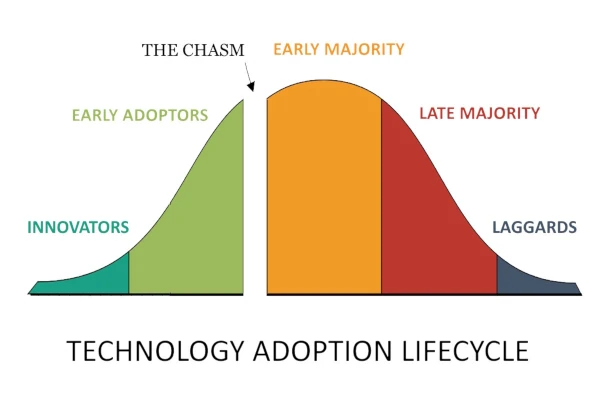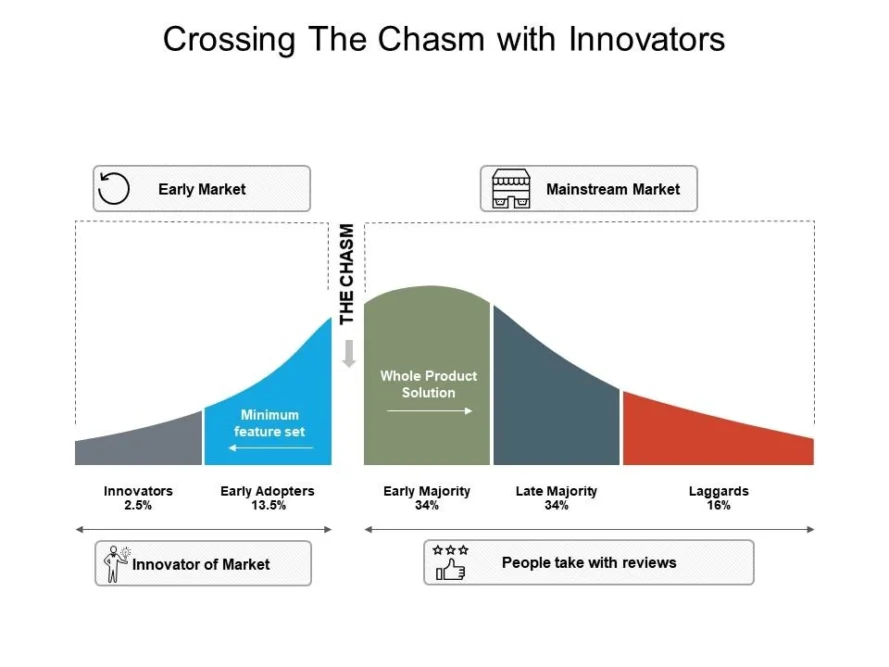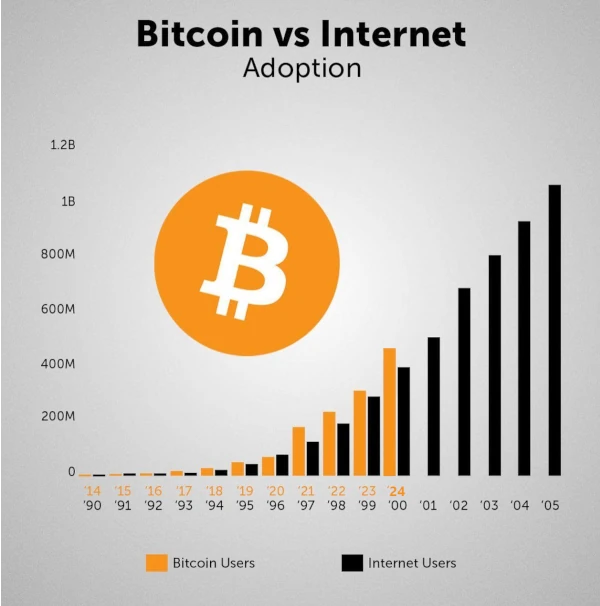Introduction
Comparison Bitcoin and Internet adoption have many reasons. How went Internet adoption and how it was in case of Bitcoin?
In this articles all about comparison both of this innovations – Internet and Bitcoin. I will write about innovation, adoption, compare both innovations. After this article I would to answer question: “is bitcoin innovation quicker adopted than internet?”
Please read, share and comment!
Let’s go!
The Chasm
Every innovation become mainstream projects after time. Products on the market follow technology adoption life cycle.

Every group has different motivations in using new technology. First two groups are innovators and early adopters. They are technology driven and always looking for some new technology to test it. Here is key point in mainstream adoption.
Chasm between early adopters and early majority decide if technology will be in mainstream or not.
As like I write before groups needs different motivations. In case of early majority it is use cases for Bitcoin and another cryptocurrencies. I would write early majority are practical people with tendencies to technology – well proved.
Then, we have late majority – conservatives. Group of people not really open for technology, but if technology is widely accepted and many people use it they will follow as well.
To the last group – laggards belong people very conservative and won’t accept new technology if they don’t have to. Ok, then but what’s really mean crossing the chasm?
Crossing the Chasm
In the first section I have written just about groups in technology adoption and their motivations. Let’s go forward and take a look below.

After this graph is obvious. Crossing the chasm is reaching amount of users from early market to mainstream market. How difficult it is? It’s it, indeed.
Mainstream market is 84% of whole market!
There is something to fight for. Once a product enters the mainstream phase, the game changes completely.
In mainstream phase the product acceptance mechanism is self-winding.
And of course, at the end there will be those who do not want to use new technologies at all costs.
A very real example of a grandmother who once had problems using a smartphone and the Internet. And today? This is nothing special for this group of older people.
Comparison Bitcoin and Internet – Internet Innovation

It’s time little bit write about Internet as innovation. I am pretty sure right now you think Internet as innovation. What are you talking about, but wait before Internet reach actual form a lot improvements happen.
So how did it all start with the Internet?
Well, today all we know The World Wide Web and I guess most of us even don’t think how many things happen before Internet were really invented in 1989 in CERN.
Of course, I won’t write whole Internet story, but… a few important key points for Internet development.
Everything starts from conception and with Internet it was the same.
Intergalactic Network
In the 1960s, J.C.R. Licklider, an American psychologist and computer scientist, introduced the groundbreaking concept of an “Intergalactic Network.” His vision? A globally interconnected set of computers through which everyone could quickly access data and programs from any site.
Licklider’s concept laid the foundation for the modern internet. It propelled the development of ARPANET, the first network to implement the TCP/IP protocol suite that underpins today’s internet.
In the 1980s, the internet’s development took a quantum leap with the TCP/IP protocol, spearheaded by Vint Cerf and Bob Kahn. This protocol became the language of the internet, allowing different computer networks to communicate seamlessly.
1983 was a landmark year, as ARPANET adopted TCP/IP as its standard protocol. This decision wasn’t just a technical upgrade but a transformative step that unified multiple, isolated networks into an interconnected network of networks – what we now know as the internet.
In 1989, while at CERN, Tim Berners-Lee conceptualized the World Wide Web. Not to be confused with the internet itself, the Web is like a vast, sprawling library that Berners-Lee built on the existing internet infrastructure. It’s a system of interlinked hypertext documents – a digital universe of websites and web pages accessible via the internet.
Right now you see how many pivots happen before Internet reach actual form. Surprised?
Let’s jump into Bitcoin innovation history.
Comparison Bitcoin and Internet – Bitcoin Innovation

Bitcoin is innovation as well. If you have doubts then for sure you don’t nothing about innovation itself. Bitcoin is disruptive as a form of payment, but also store of value and great cryptographic project.
Indeed I am right, but it’s not what I am trying here establish.
My point is, that from 2009 happen things what brings Bitcoin closer to mainstream.
Let’s take a look for those steps and try to answer if they are enough.
- 2009 – Bitcoin Whitepaper and beginnings
- 2010 – First Exchange hacks and enthusiasts words spread
- 2010 – Bitcoin Pizza Day – first transaction in Bitcoin
- 2012 – First halving on blockchain
- 2013- $100 for one Bitcoin – why not?
- 2013 – Historical bull run – $1100 for one Bitcoin
- 2014 – First huge volatility – Bitcoin Bear Market
- 2016 – Second halving on blockchain
- 2017 – Early adopters rise Bitcoin price to $20000
- 2018 – Second Bear Market
- 2020 – Third halving on blockchain
- 2021 – Bitcoin price on $67100 after Bull run
- 2022 – Huge Cryptocurrency Winter
- 2023 – First Hope on the Bitcoin market
- 2024 – Fourth halving on Bitcoin
- 2024 – First Bitcoin ETF on exchanges
- 2025 – All Time High on $108700
- 2025 – We are still in the Bull Run and a lot can happen
As like you see a lot of happen, but I didn’t mention about some things like technological improvements or launching Lightening Network. What do you can say?
Bitcoin cross the chasm or early adopters need to push project even more?
After this little memory of Bitcoin history is finally time to compare Bitcoin and Internet. This comparison would be in case of adoption and a few another aspects.
Comparison Bitcoin and Internet
Without Internet there would be any Bitcoin, because innovation of Internet open widow for “Internet Money” – Bitcoin.
In some point it was obvious that Internet need have own money implementation.
20 years after the invention of the Internet, Bitcoin was created.
Adoption Speed Comparison

Looking at how the internet and Bitcoin grew shows some interesting patterns. Research shows that Bitcoin is growing faster than the internet did in its early days. While the internet took seven years to grow from 16 million to 70 million users, Bitcoin did it in just four years.
Bitcoin should reach 1 billion users by 2025. This is a big deal as it means that Bitcoin will hit this milestone in half the time the internet needed. On top of that, MatrixPort data shows crypto users make up 7.51% of the world population, and this could reach 8% by 2025.
We can trace Bitcoin’s faster adoption to institutional interest and better market infrastructure. The rise of Bitcoin has led to price rallies each time financial markets added new ways to buy Bitcoin.
User Demographics and Behaviour
Recent demographic data shows interesting patterns in how different age groups and regions adopt cryptocurrency. Millennials are leading the way, with 20% of them actively using cryptocurrency.
Age Group Analysis
Young adults rule the crypto world. 94% of buyers are between ages 18-40. Gen Z and Millennials show lots of interest because they grew up with digital tech. Men under 50 are more likely to jump in, with 42% of men aged 18-29 using cryptocurrency. Women in the same age group show lower numbers at 17%.
You can read more about Facts about cryptocurrency trading.
Geographic Distribution
The crypto adoption race has a clear leader. Central & Southern Asia and Oceania top the charts with seven of the top 20 countries in this region. Asian adults stand out with 28% having invested in cryptocurrency, which puts them ahead of other ethnic groups. Countries with lower-middle income have jumped on board too, making up 40% of the world’s population.
Usage Patterns
People use crypto in different ways. Here’s what the numbers tell us:
- 79% trade or invest
- 24% shop online
- 6.5% play virtual games
- 5.8% make face-to-face payments
Most people get into crypto to make money, with 67.5% joining just to trade. Users care about stability and network reliability next. 61% of crypto owners keep holding onto their coins, which shows they’re staying put even when markets go up and down.
Money matters when it comes to crypto use. 23% of upper-income households take part in crypto activities. The numbers paint a clear picture – young, tech-savvy people are pushing crypto forward, but the user base keeps growing to include people of all backgrounds and regions.
Conclusions
Comparison Bitcoin and Internet make sense. Without one innovation there would be not another one.
Bitcoin’s growth mirrors the internet’s early days but at a much quicker pace. Recent data shows Bitcoin has attracted the same number of users in half the internet’s timeline. This acceleration demonstrates the remarkable adoption rate of modern technologies.
Bitcoin users are predominantly young adults aged 18-40. Their natural comfort with the digital world makes them more likely to embrace Bitcoin as an investment vehicle. Major corporations have also shown their confidence in Bitcoin’s potential through substantial ETF investments.
Analytics suggest Bitcoin will reach the one-billion-user mark by 2025. The internet needed 14 years to hit this milestone, yet Bitcoin is on track to achieve it in just 7 years. This momentum points to Bitcoin’s continued growth as it reshapes our understanding and use of money.

Leave a Reply
You must be logged in to post a comment.